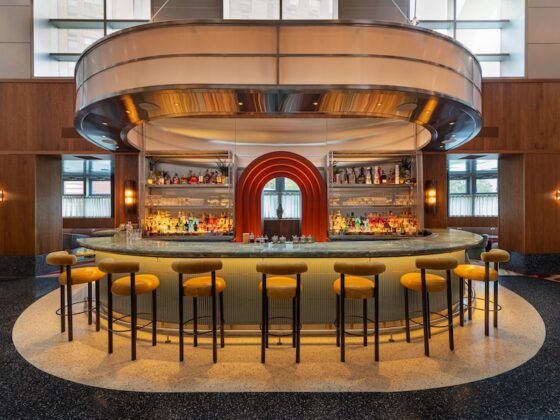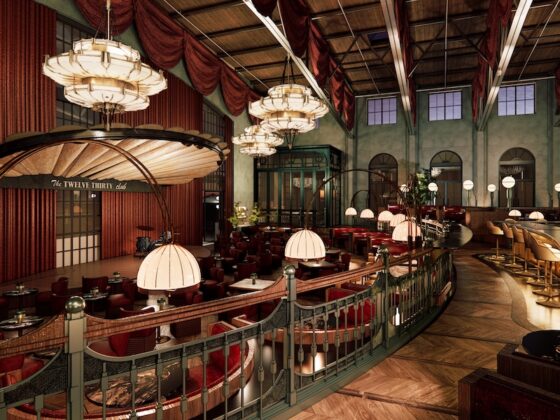Mark Scott, General Manager Canada at Shiji Group, draws from his 20+ years of experience in Food and Beverage and in the Computer Software Industry catered to F&B to speak to Insights about how the pandemic has changed the F&B landscape, especially with regards to the adoption and use of technology, even offering some predictions on future solutions.


What did you notice as the biggest changes to F&B brought on by the pandemic?
When I think back on the situation with online ordering pre-pandemic, there was a lot of reluctance to use online and mobile ordering tools, whether it’s from Amazon or any other supplier. The pandemic was a tipping point where those who had been reluctant to use some of these technologies ultimately ended up with little choice but to do so. Similarly, in the F&B space, there was some initial resistance to the various new ways of ordering food that were brought about by the restrictions and other factors, such as not wanting to be in close proximity to people, resistance to holding or touching constantly shared items like menus and so on, and I think this changed attitudes.
The willingness to try technologies got to a point where it became less of an option and made those who were reluctant more comfortable after a while. Moreover, during the worst times, hotels and restaurants were closed, so a good deal of adaptation was required. Stand-alone restaurants were open for the most part; for hotels that stayed open, their restaurants might have also done so, but there was no in-room dining, and in some circumstances, it caused some restaurateurs to become entrepreneurs and create their own ghost kitchens. In all these cases, the use of mobile devices and online ordering became paramount to keeping the industry afloat during difficult times, as well as to keeping employees and their incomes.
It had a dramatic effect, no question, but it’s not to say that these things weren’t going to happen anyway: it was just a bit of a nudge to make more rapid changes in the industry.
It wasn’t all about business, though, I also see a concern about protecting one another. Restaurants and the Hospitality Industry, in general, were very cognizant that ultimately, once COVID was over, customers would want to revisit their business, and if they hadn’t taken the steps to try and protect people during this time, it probably wouldn’t reflect well and bring back some of them as customers.
QR codes on a table were not precipitated specifically by the COVID pandemic. On a very limited basis, one could already find them in some of the casual dining operations, but they were underutilized by customers. When COVID hit, the technology was already there and its adoption got pushed forward because of the need to do away with sharing physical menus. It wasn’t a big issue for those who were used to scrolling through their favorite food images or ordering a Friday night pizza online, but there was a bit of a learning curve for those who didn’t generally use their phones for food ordering. Therefore, for a period of time during the pandemic, customers were asked if they knew how to use the QR code upon stepping into a restaurant, and staff would walk them through the process. As time went on, people became comfortable with it, and it didn’t take long to level the playing field between experienced and inexperienced users. In fact, we’re seeing that while there’s been a move back towards no restrictions and the return of physical menus, people tend to continue using the QR codes that remain on the tables. This shows us it’s a technology that is here to stay, in one form or another, as we see the use of QR codes from restaurants being now emulated by hotels for in-room dining. Operators are using it as a way to bring more growth in revenue, either by providing devices such as a tablet in the guest room or by facilitating the use of a guest’s own device, which allows for better visualization of the menu items, as well as time to think and choose one’s order, as opposed to rapidly having to place it through a phone call, where a guest might get rushed or not have the option to add an item that they otherwise would want if it had been shown to them.
When looking at the menu digitization perspective, I think that what we’re going to see is a broadening use of it in multiple areas. Looking ahead to five to ten years, it’s extremely difficult to know what will happen as circumstances change rapidly and new technologies appear that help drive the expansion and use of the digital menu and other technologies. I sometimes say that I should have probably thought of being a carpenter, as at the very least I’d know how to cut a piece of wood and it wouldn’t change from one day to the next. With technology, in the Hospitality Industry as with anything else, the constant is that things are always changing. And it’s all about ease of use and dealing with issues that restaurateurs face daily, such as labor challenges, and how we can find ways for technology to mitigate those issues. Anything we can do to limit the contact, make staff more productive, or generate more revenue as business models change is the likely way I believe digital and technology will go.
Another example of existing technology that showed up a few years ago and got a push during the pandemic is robotic delivery units. At trade shows, one inevitably comes across a robotic food delivery mechanical unit floating around handing out food. And I can easily see that becoming more prevalent, not just in the restaurant space as a food runner, but also in a hotel as part of the in-room dining experience. It may seem a little out there to have some robot at the door dropping off your food, but a lot of other tech also seemed that way if we go back a few years, and look at where we are now.
As discussed, mobile is a big part of the behavioral changes, which relates to the reluctance to get back into full contact mode. Restaurants have had to deal not only with the technological side but also with ensuring they have great air filtration systems and hygienic policies such as hand sanitizers and masks, since some customers may not be prepared to take risks with their health. I see this continuing for quite some time, especially with the different virus variants popping up here and there.
RELATED
Then there are some things that became a habit, like the use of contactless payments. In Canada, this has been around for quite a while and is everywhere, but when I used to visit the US and tap the device for payment, I often heard a comment from the staff behind the counter expressing their surprise at having a customer use that function. Now, even globally, more people are aware of it and using that capability.
When the pandemic hit, it brought about changes in the business model and there was a need for solutions to be developed quickly, with some that came out very rapidly and dealt with the aforementioned behavioral changes. However, with the increased use of mobile devices, there was suddenly an equally rising amount of data involved, and a lot of providers may have compromised in some ways on data protection, security, and sovereignty to be able to satisfy their customer base’s needs. This is now an area where we see companies that did not approach the development of new products with data security in mind from the very beginning being made to backtrack, as they are exposed.
“There are two ways to look at it. One of them is that you want technology to lessen the load on the existing waitstaff by transferring some of the transactional activity to the customer. The second is to make existing systems function in a more productive manner.” Marc Scott, General Manager Canada at Shiji Group
How do you see the proliferation of delivery services during the pandemic?
This started getting off the ground just prior to COVID and it was catching on, but just as the crisis hit and dining restrictions kicked in, third-party delivery really took off. The challenge with this, at the beginning and up to fairly recently, is that the parameters under which restaurants had to engage the delivery companies didn’t allow them to raise additional fees for delivery when an order came through one of these third-party services. This meant that the cost of delivering that order came straight off the top and oftentimes resulted in barely making a profit on it. As time went on, the competition in that space increased dramatically, and therefore there were more options for restaurateurs. What we started to see relatively recently is that competition is driving delivery costs down, changing the limitations on recovering those costs, and it’s still going to be something very prevalent as customers and businesses are taking advantage of it. It was hard to adjust to, as anything would, especially at the start when the service was extremely costly for restaurants to adopt but the alternative was even worse, making it the lesser of two evils then. Now I see it as a more equitable arrangement, becoming more so all the time, and I don’t think it’s going away.
There are two ways to look at it. One of them is that you want technology to lessen the load on the existing waitstaff by transferring some of the transactional activity to the customer. The second is to make existing systems function in a more productive manner.
When trying to lessen the load on the staff, we’re seeing the use of mobile devices come in, such as tablets at the table or self-service kiosks, all of which eliminate the need to have staff present and transfer control of the transaction to the customer. And this is valid not only for the upfront part of the mobile experience but also for the back end, which is the use of mobile payments. One of the classic challenges a customer experiences is not finding the server at the end of a meal and waiting for the bill – frustrations mount, satisfaction drops, and this mars what had otherwise been a great dining experience and excellent service up to that point. A way to bypass that could be the use of mobile payments by scanning a barcode on the check, letting the customer take control of the transaction, make payment, and leave at their convenience. This would also allow the restaurant to have higher table turns, helping to enhance productivity but also lessening the staff’s workload.
When trying to enhance the productivity of existing systems, an example is how many restaurants have kitchen display systems but tend not to use them in what’s called a food runner model. So it still results in an order going to the kitchen, being prepared, and then the waitstaff needs to go back to the kitchen, get the order, bring it out, and deliver it to the table. This takes them off the floor and robs them of time that could be used for upselling or immediately attending to guests; whereas with food runners, the same number of staff members can take care of more tables at any one time. This may seem like something that invites resistance from the servers’ perspective, but more tables can mean more tipping opportunities and potentially less walking back and forth to the kitchen during a shift. One thing I’ve noticed since we’ve bounced back from COVID is the number of managers acting as food runners, thus reducing the need for more waitstaff, to the tune of one food runner working between three or four waiters, which has helped deal with some of the pressures of the labor crunch.
Which areas do you consider ripe for further development by tech providers?
Apart from keeping data sovereignty and security in mind when developing new solutions, artificial intelligence is another field that is most beneficial when dealing with the growing amount of data being generated.
As there is so much more data being collected, we might see more applications using AI for predictive patterns in different aspects of the business, from inventory to other uses. Some business intelligence tools can be very powerful in providing oversight and predictability, but their development must keep ease of use in mind, benefitting independent restaurateurs as much as big players. I do think AI is going to find its way to grow in this space in the next few years, but the exact solutions coming out of that I cannot be sure of yet. I find it fascinating to read about AI and all the things it can detect that humans don’t notice when looking at data, so I believe it will change the direction of how things go, hopefully for the good.







